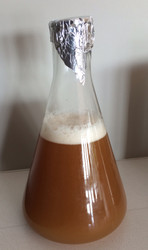Yeast, that often highly underrated ingredient we use in brewing – the turner of wort into beer. Sometimes it just doesn’t follow what we have planned for our beer. We’ve all experienced fermentation issues when brewing, and it’s something we get asked about regularly here at Brewshop, so we’ve put together a few yeast troubleshooting items and hope that it may help your brewing.
Fermentation Fails to Start
The primary reason for fermentation to not start is the health of the yeast, or too little healthy yeast, and this is usually the cause. Perhaps the packet or vial of yeast was old and there was little healthy yeast left to do the job. Occasionally it can be the wort that you’ve pitched the yeast into – was it too hot, or too cold?
The general rule is that if fermentation hasn’t started after 18 hours (or 36 for lagers), then you may need to take action to remedy it by pitching more healthy yeast, but do check carefully as fermentation may be happening but with little visible signs.
Slow Start to Fermentation
Yeast go through what White and Zainasheff (2010) describe in their book* as the “Lag Phase”. This phase can extend to around 15 hours, so don’t be too hasty to think it’s not going to plan. Some things that can impact initial yeast growth include:
- Pitching rate – perhaps the most common cause of a slow start, so make sure you pitch the right amount of yeast.
- Oxygenation – was there enough oxygen in the wort for the yeast?
- Temperature – was the temperature close to expected when initially pitching? Were there any major fluctuations in temperature at any point during fermentation?
Fermentation Stops Mid-Way
Some yeast strains are prone to stop mid-way through fermentation and brewers need to monitor this closely. Most will spring back into life with a bit of nuturing, but occasionally nothing will kick it into action and you may need to repitch yeast to finish it off. Some things that can be done to encourage attentuation:
- Increase the temperature. Yeast is more active at higher temperatures.
- Transfer the beer to another vessel. This is intended to bring the yeast back into suspension and hopefully back into action.
- Swirl (or gently rouse) the yeast – another way to bring the yeast back into suspension.
Low Attenuation
Should your beer not quite reach the intended final gravity and the hydrometer reading is higher than it should be, firstly make sure the yeast has completely finished by taking a second reading after 24 hours. It may look like it’s finished but some of the yeast may be quietly working away and you need to ensure fermentation has stopped completely before worrying about low attention.
However, if you still have a low attenuation problem then here are some suggestions:
- The composition of your recipe – too much crystal malt or adjuncts can create a less fermentable wort for the yeast.
- Mash temperature – too high a mash temperature can create a less fermentable wort.
- Low fermentation temperature – if the temperature is too low, especially at the beginning of fermentation, the yeast may slow considerably or stop completely.
- Fluctuating fermentation temperature – yeast work best at a fairly constant temperature and are sensitive to large temperature changes which can cause it to slow or stop.
- Insufficient oxygen – yeast require oxygen at the beginning of fermentation and the lack of oxygen will inhibit growth. Oxygen has been boiled out of the wort by the time it reaches the fermenter so it needs to be reintroduced through splashing, mixing, or using a wort aerator or oxygen wand prior to pitching the yeast.
Super High Attenuation
While there could be reasons for an unexpectedly high attenuation reading, like a low mash temperature, a wildly low hydrometer reading of your finished beer is often a sign of infection or contamination of some sort. In some cases, an infected beer is still drinkable, but there is little that can be done should this not be the case. Watch your hygiene and learn for the next brew.
* For more indepth yeast information and a great resource for any brewer, we recommend Chris White and Jamil Zainasheff’s (2010) book Yeast: The Practical Guide to Beer Fermentation.
